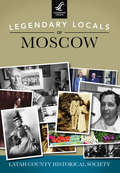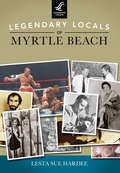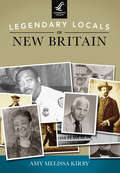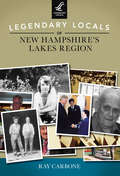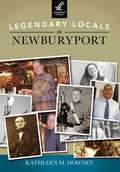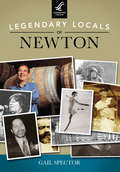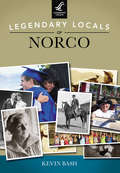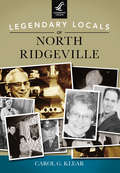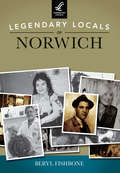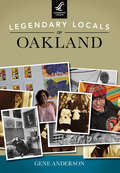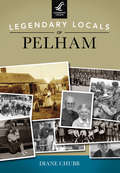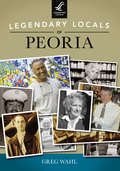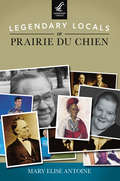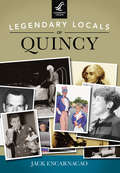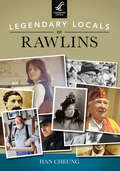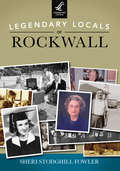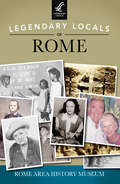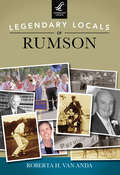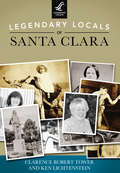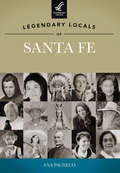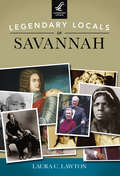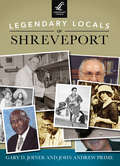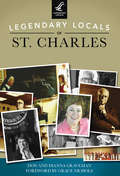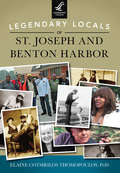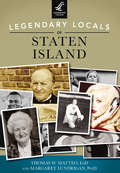- Table View
- List View
Legendary Locals of Moscow
by Latah County Historical SocietyThe rich and fertile land upon which Moscow sits has sustained a vibrant community of hard working thinkers, creators, and activists for more than 125 years. Just as the area's first inhabitants returned to camas fields in Paradise Valley year after year, pioneers settled in "Hog Heaven" because they found ready access to life's necessities. Businessmen like Nathaniel Williamson and Frank David tied their fortunes to the local farming economy to the same degree as seed pioneer Willis Crites or sustainability advocate Mary Jane Butters. While the bounty that surrounds Moscow feeds its growth, the town's cultural lifeblood is pumped by the University of Idaho. The university has provided Moscow with inventors such as Malcolm Renfrew, talented athletes like Olympian Dan O'Brien, and colorful characters, perhaps best embodied by Dean of Women Permeal French. The picturesque hills of the Palouse roll through the history of this unique town, rooting tomorrow's leaders in the work of yesterday's groundbreakers.
Legendary Locals of Myrtle Beach
by Lesta Sue HardeeSimeon B. Chapin was an entrepreneur and visionary who, along with Franklin G. Burroughs, helped create the foundation of what is Myrtle Beach today. B.B. Benfield built and opened the area's first movie theater, and Lawrence Boulier was a landscape artist and founder of the Waccamaw Arts and Crafts Guild. John Woodside built the grand Ocean Forest Hotel. Col. H.B. Springs was the town's first insurance and real estate agent, and James Bryan Sr. was the first president of Myrtle Beach Farms. Blanche Floyd was a beloved teacher and author, and W.L. Harrelson made history by serving as Myrtle Beach's first mayor. Earl Husted brought the first amusement park rides to this area, and Anthony James left after high school to make a name for himself as the first widely known actor from the Myrtle Beach area. The stories of these Myrtle Beach notables and many more fill the pages of this book. Some of these names may be unfamiliar, but each of these legendary locals, in his or her own way, has helped make Myrtle Beach the historical hometown and vacationers' paradise that it is today.
Legendary Locals of New Britain (Legendary Locals)
by Amy Melissa KirbyNew Britain began in 1754 as an ecclesiastical society and farming village, and with few natural resources, was transformed into a modern industrial city by the time of its incorporation in 1871. Attracting waves of immigrant workers and entrepreneurs, this became a diverse but unified community in which people of all ethnicities worked together, served together in times of war, and even played together on the baseball fields. Legendary Locals of New Britain includes remarkable residents among the early inhabitants and settlers; the people and institutions that brought New Britain to cityhood; artists and entertainers; famous or leading immigrants; sports legends; and men and women who have otherwise made their mark on New Britain, the nation, or the world.
Legendary Locals of New Hampshire's Lakes Region (Legendary Locals)
by Ray CarboneThere are few places in America that have such a rich variety of landscape and scenery as the Lakes Region of New Hampshire: from the summer calm of Squam Lake to the robust white winter mountaintops of the Gunstock Mountain Resort. So it is no surprise that the people who call it home reflect the same wide palette of humankind--from the pre-Revolutionary War surveyors who first marked their initials on a rock at Weirs Beach to Bob Lawton, the current owner of the world's largest arcade; from one of George Washington's inner circle to Ernest Thompson, the award-winning author of On Golden Pond. The Lakes Region draws them--or grows them--all, because it has it all.
Legendary Locals of Newburyport
by Kathleen M. DowneyYeat! The colloquial greeting is distinctly Newburyport, uttered by this seaport's citizens to acknowledge one another in passing or to seek out fellow locals in far-flung places. Individuals featured in Legendary Locals of Newburyport extend to readers a congenial "Yeat!" William Lloyd Garrison, native son and leading abolitionist; "Lord" Timothy Dexter, who staged his own mock funeral; Harry O'Connor, founder of the World's Shortest St. Patrick's Day Parade; James Stehlin, celebrated Newburyport High School football coach; Rhina Espaillat, award-winning poet and founder of Powwow River Poets; Richard Simkins, owner of the legendary Grog restaurant-tavern; Sue Little, owner of Jabberwocky Bookshop; Tom Maginnis, drummer for the post-punk band Buffalo Tom; Mickey, feral cat mascot for the Merrimack River Feline Rescue Society, and 1st Lt. Derek Hines, who gave his life while serving his country in Afghanistan, are among the legendary locals--native born and transplants--who have left their imprint, or paw print, upon the Port.
Legendary Locals of Newton
by Gail SpectorNewton has more than enough legendary locals to fill volumes of books. Endless are the stories about men, women, and young people who dedicated, or still dedicate, countless hours of their lives in order to make Newton and the world a better place. Newton has been a launching ground for award-winning authors, Nobel Prize winners, Olympic medalists, and Hollywood stars. Some of Boston's best athletes have chosen to make "the Garden City" their home. In the pages of this book, readers will learn about Newton's first mayor, James Hyde, who never lost an election in more than 50 times on the ballot; Rev. Edmond Kelley, the first pastor at Myrtle Baptist Church and a former slave; Leonard Zakim, regional director of the Anti-Defamation League who dedicated his life to fighting prejudice and civil rights violations; Louise Bruyn, who walked from Newton to Washington, DC, to protest the Vietnam War; Shirley Lewis, known as the "regal queen of the blues"; and Ted Williams, regarded as baseball's greatest hitter, who lived in Newton Upper Falls.
Legendary Locals of Norco (Legendary Locals)
by Kevin BashFrom its beginning as a poultry powerhouse to World War II Navy town and to Horse Town USA, Norco has been known over time as a community of go-getters and dreamers with unparalleled volunteerism, stubbornly protecting a rural way of life. Founder Rex Clark wished for families to be self-sustaining with what they could grow and raise on their property; wounded Marine Johnny Winterholler, against incredible odds, led the way for other disabled veterans as the star of the famed wheelchair basketball team the Rolling Devils; and Tamara Ivie fulfilled her impossible dream to play professional baseball. And regular folks, known once as "Acres of Neighbors," stepped up to create a city of "elbow room," stopping cold, big-money developers wishing to cut the community into small lots. Today, Norco is an equestrian paradise with trails on most streets and plentiful open space. For decades, this small community has produced activists, ballplayers, college presidents, physicians, actors, cowboys, and lots of Norconians who give back to the community that raised them.
Legendary Locals of North Ridgeville
by Carol G. KlearIt was 1810 when a group of men from Connecticut roved west to Ohio, establishing the first permanent settlement in what became North Ridgeville. Led by David Beebe Sr., they foraged for food and shelter. The pioneer spirit of the aggregation sustained them and others who followed. Farming provided sustenance and many farms including those owned by the Solomons, Gerharts, and others have continued the tradition. Education was greatly respected and 10 school districts became part of the community's landscape. An early school still stands on Jaycox Road, where retired teachers Julie Bajda and Barb Sutton reenacted the roles of teachers from earlier times. The former Buffalo Trail became Center Ridge Road, the city's main thoroughfare, and, in 1960, the township developed into a city governed by a mayor, council, and various department heads. Businesses, such as Buescher's Hardware and the Bogner Funeral Home opened and remain today. Groups of residents cultivated interests into organizations with a goal of working together seamlessly for the good of the community.
Legendary Locals of Norwich
by Beryl FishboneNorwich measured nine square miles in the 1659 deed that Mohegan chief Uncas gave to the brave English settlers from Old Saybrook. The names of the city's streets and parks are testaments of the pride the community has in its town's residents and history. Stories abound of Norwich natives and American revolutionaries like John Durkee, who made the king's tax representative resign; scoundrel Maj. John Mason, who ordered the Mystic massacre of 100 men; and traitor Benedict Arnold, who burned the nearby city of New London. Legendary Locals of Norwich also sheds light on Norwich's more modern heroes and heroines, whose everyday actions give homage to the past, recognition to the present, and courage and vision to the future. Featured are Stanley Israelite, whose personal drive has helped businesses and individuals succeed; Eileen Akers, whose actions changed the world for students; the philanthropy of Harold Ross; and the pride of retailer Jackie Quercia.
Legendary Locals of Oakland
by Gene AndersonOakland has been shaped by the transcontinental railroad, freeways, earthquakes, and its location on the shores of San Francisco Bay. But what makes Oakland such an amazing city are the people who have called Oakland home over the years, like Mayor Samuel Merritt, who helped make Oakland the terminus of the transcontinental railroad; Elizabeth Flood, who worked to desegregate Oakland schools in the 1870s; and F.M. "Borax" Smith, who created the Key System. Oakland has been home to game-changing athletes like "father of modern tennis" Don Budge and Curt Flood, who helped bring free agency to sports; artists like writer Jack London, dancer Isadora Duncan, poet Joaquin Miller, and cartoonist Morrie Turner; and culture-shaping movements like the Black Panther Party. However, the impact of Oaklanders is not just historical. From Oscar Grant to Favianna Rodriguez to Marshawn Lynch to Jerry Brown, people in Oakland continue to shape not just "the Town," but the entire country.
Legendary Locals of Pelham
by Diane ChubbFrom its start as a farming community, Pelham has been a place for dreamers and visionaries. It has been home to NASA astronaut Richard Linnehan and current NASCAR host Meghan Lamontagne, who made her television debut winning America's Funniest Home Videos. Pelham has many other residents who may not have reached for the stars but instead focused on making a great community. Harry Atwood ran Atwood's Store, which housed the post office until 1965. Aunt Molly served as librarian at the Pelham Public Library for more than 55 years. The Harris family's Pelham Inn has always welcomed visitors from all over the region. Originally a parade group, the Starlighters Drum & Bugle Corps was soon participating in world open competitions. Twins John and Charles Steck buzzed above the town from their plane but also performed search and rescue missions. Longtime resident Eleanor Burton remembers all her students, served on every committee, and still actively volunteers. These legendary locals are people who, in their own comical or poignant way, have shared their vision to create our community.
Legendary Locals of Peoria
by Greg WahlPeoria harkens back to the 1670s glory days of the French voyageurs and became the now-familiar face of Americana--its townsfolk have touched every aspect of national and international life, often significantly. In comedy, Fibber McGee and Molly, Charles Correll, Richard Pryor, Sam Kinison, and even Bishop Sheen with his witty homilies have made Peoria the "Habitat of Humor." Betty Friedan's The Feminine Mystique jump-started the 1960s feminist movement, while Philip José Farmer's The Lovers rocked the 1950s sci-fi universe. Dr. C.T. Vivian, Dr. Romeo Garrett, and John Gwynn Jr. held the frontline against racism. Representing the best of society's core values, Barb and Dick Hammond founded Friends of the Children of Haiti, a medical organization tending to the year-round needs of the earth's poorest. And unheralded Bill Noel has shouldered the sorrows and burdens of others who have leaned on him for decades. When it comes to all the legendary locals, they play in Peoria . . . and the world.
Legendary Locals of Prairie du Chien
by Mary Elise AntoineFrom the day Jacques Marquette and Louis Joliet entered the Mississippi River in 1673, fur traders, and then settlers, were drawn to Prairie du Chien. Red Bird and Black Hawk opposed American expansionism, while Zachary Taylor enforced the change. John Muir admired the majesty of the Mississippi River, and John Lawler accepted the challenge to bridge the waters. As people came to Prairie du Chien, generations worked to form a small, cohesive community. Some, like George and Dorothy Jeffers, Ralph and Albina Kozelka, Henry Howe, and Frank Stark, began businesses that descendants continue to operate. John Peacock and Mike Valley found a livelihood from the river. Art Frydenlund, Jim Bittner, and Fred LaPointe promoted and encouraged all to come. B.A. Kennedy and Jack Mulrooney created an outstanding educational and sports program. Peter Scanlan and Cal Peters recorded the rich history. Roy and Geraldine George established the George Family Foundation, and Morris MacFarlane led a movement to create scholarships. Lori Knapp helped disabled people without realizing her impact. Politician Patrick Lucey and cowgirl Elaine Kramer gained national recognition. All these people and others, like Dr. T.F. Farrell and Robert Garrity, were neighbors. Their stories fill these pages.
Legendary Locals of Quincy
by Jack EncarnacaoFrom presidents and patriots, to locals engaged in service both heartwarming and heartbreaking, Quincy has been a place where names endure. On Adams Street, a stately mansion evokes the nation's second president and his storied kin, while the nearby Bernazzani Elementary School recalls a beloved educator who died after suffering a medical episode during a school committee meeting. In addition to two presidents and John Hancock, Quincy also birthed Dunkin' Donuts and Howard Johnson's, Hollywood stars Ruth Gordon and Bill Dana, punk rock legends the Dropkick Murphys, and a host of prominent industrialists who made quarrying and shipbuilding Quincy's national calling cards. Less renowned but equally ingrained are the city's local characters. Memories of Mike "The Winger" Zadrozny launching vinyl records like Frisbees around the city still elicit nostalgia. Generations who played Little League in the Koch Club recall Richard Koch's commitment to community. The homeless honor Fr. William McCarthy, who founded the shelter Father Bill's Place and personified charity. These legendary names--individuals both towering and humble--made Quincy a uniquely American city and kept it that way.
Legendary Locals of Rawlins
by Han CheungFounded as a railroad town in 1868, Rawlins was smack in the middle of the Wild West that attracted so many adventure-seekers from the East, such as Clare Espy, who rode into town alone at 12 years old and became a successful cowboy. When the town outgrew its outlaw days and was ready to be incorporated, its people chose a leader in Isaac Miller, a Danish man who exemplified the story of the American dream. Being in the first state to allow women the right to vote, Rawlins has had its share of women's firsts. Lillian Heath was Wyoming's first female physician, and Valerie Nelson is its first female railroad engineer. The boom and bust cycle of the area saw many residents come and go, but some families, like the Frances and Espys, have been here since the beginning and continue to be well respected. Rawlins is facing another boom with several incoming energy projects. While Rawlins's future is exciting, this volume takes a look at its past and the people who have made the town what it is today.
Legendary Locals of Rockwall (Legendary Locals)
by Sheri Stodghill FowlerSince its founding in 1854, Rockwall has been home to dedicated public servants, pioneer personalities, hometown heroes, successful business owners, devoted educators, and hardworking farmers. Containing more than 100 profiles of Rockwall's interesting and influential citizens, Legendary Locals of Rockwall includes the stories of Confederate veteran John Summerfield Griffith, who rode on horseback to Austin to gain the original charter for Rockwall County; long-tenured office holders such as Lannie Stimpson, who served 53 years in office, and Derwood Wimpee, who served 35 years; a long list of educators, including Maurine Cain, Dorothy Smith Pullen, Ouida Springer, and Doris Cullins, who influenced generations of Rockwall students; and business professionals such as newspaper publishers P.J. and Jane Bounds, local developer and philanthropist Raymond Cameron, and Texas's first formally trained female dentist, Dr. Jessie Castle LaMoreaux. In addition, Rockwall has long honored its agricultural heritage by naming roads after farming families who influenced the region. The names Bourn, Rochell, Cornelius, Clem, and Smirl, among others, will be familiar to those who travel the roads of Rockwall County.
Legendary Locals of Rome
by Rome Area History MuseumIn 1834, three men chanced to meet at a spring near where the Oostanaula and Etowah converge to form the Coosa River. Looking at the freshwater spring surrounded by healthy hardwood, they mused that this would make a good place for a community. They got together with two other landowners in the area and decided to start a town. And, of course, they wanted a name for it. Following the democratic process still honored by citizens today, they each chose their favorite names, such as Pittsburg, Warsaw, and Hillsboro. The name drawn was Rome. If the last name had been drawn, which was Hamburg, the town would be full of "Hamburgers" instead of the Romans that reside there today.
Legendary Locals of Rumson
by Roberta H. Van AndaIn Rumson's formative years, people journeyed to the Jersey Shore to escape the heat and pestilence in the cities. In what is now Rumson, river-to-river land parcels were developed into farms and country estates for the elite of New York City. Along with "the Baking Powder King" and "the Calico King," another of Rumson's notable residents was a US Secretary of the Interior who was asked to run for vice president, refused the honor, and left the position open for the second choice, Teddy Roosevelt. Today, one of the world's most famous and enduring singing stars and one of America's most famous chefs have ties to the town. Rumson has been the home of entertainers, sports stars, financiers, entrepreneurs, scientists, brewers, legislators, philanthropists, and jurists. It is a community that brings together people of varied interests, ages, and walks of life yet still remains a warm and comfortable small town.
Legendary Locals of Santa Clara (Legendary Locals)
by Clarence Robert Tower Ken LichtensteinThe city of Santa Clara lies in the very heart of the Santa Clara Valley, directly south of San Francisco Bay. It is the home base of the internationally famous Santa Clara Swim Club, the equally famous synchronized swim team the Santa Clara Aquamaids, the International Swim Center, and the San Francisco 49ers professional football team. It boasts world-class parks, theaters, museums, acting groups, a featured chorale, a nationally ranked drum and bugle corps, a major theme park, a convention center, and a first-class hotel system for those who wish to visit. Legendary Locals of Santa Clara celebrates the people who guided all of this to its realization.
Legendary Locals of Santa Fe (Legendary Locals)
by Ana PachecoFounded in 1610, Santa Fe has been a beacon for those yearning for adventure, a different way of life, a place of expression, and the opportunity to meld the old with the new. Designated America�s first United Nations Educational, Scientific and Cultural Organization Creative City in 2005, Santa Fe is home to people from around the world. Legendary Locals of Santa Fe pays tribute to a diverse group of individuals, who through different eras have contributed to the city�s vitality: Native American Po�pay, leader of the Pueblo Revolt; world-renowned sculptor Allan Houser; performing artist Maria Benitez, who rejuvenated the genre of Spanish Flamenco dance and music; Pulitzer Prize authors Willa Cather and Oliver La Farge; Fray Angelico Chavez, Santa Fe�s preeminent historian; Santa Fe Opera founder John Crosby; Stewart L. Udall, former Secretary of the Interior under the Kennedy and Johnson administrations; and Sgt. Leroy A. Petry, the 2011 Medal of Honor recipient. All share an enduring spirit and belief in the community that the Spanish explorers had the foresight to name �the City of Holy Faith.�
Legendary Locals of Savannah (Legendary Locals)
by Laura C. LawtonOn Sunday mornings, church bells ring, calling all denominations, and Savannah's squares are filled with people and activities. The city embraces music, art, and literature, and the historic district welcomes visitors from all over the world. As a port city, Savannah has always embraced diversity, and that is what residents love about it. We are not losing our Southern values and traditions; we are just sharing them. Legendary Locals of Savannah introduces readers to people who braved the Atlantic Ocean to establish the Georgia colony, entrepreneurs who made a fortune in cotton, and black citizens who struggled through slavery and later fought for civil rights. Liberty boys who plotted the Revolution, families who lived in mansions, boys who fought bravely for the Confederate cause, and those who insisted on preserving our beautiful historic district--they all have a story to tell.
Legendary Locals of Shreveport (Legendary Locals)
by John Andrew Prime Gary D. JoinerLegendary Locals of Shreveport chronicles fascinating people who have made a difference in the Shreveport-Bossier City area. Some are good, some are bad, and more than a few are wicked. There are movie starlets, entertainers, decorated war veterans, gangsters, preachers, madams, politicians, giants of industry, and humble folk who rose to greatness or infamy. Shreveport began as a rough and tumble frontier town that came late to being "civilized." A Baptist preacher shot one of Quantrill's Raiders when he rode his horse into church during a Sunday service. The most famous madam in the region was also a suffragette. The first successful bankers in Shreveport were immigrants from Prussia who developed a business model that extends into the modern era. Shreveport lost one quarter of its population in less than a month due to a yellow fever epidemic. And that is just the beginning.
Legendary Locals of St. Charles (Legendary Locals)
by Grace Nichols Don Graveman Dianna GravemanToday's citizens of St. Charles will recognize the names of many early settlers and residents, such as Louis Blanchette, who founded the settlement that would later become St. Charles; St. Rose Philippine Duchesne, who helped found the first school of the Society of the Sacred Heart in America; and Lewis and Clark, who began their expedition here to explore the Louisiana Purchase territory. Later came photographer Rudolph Goebel, who chronicled St. Charles's history for more than 50 years; Jane Crider, advocate for adults with disabilities and cofounder of Boone Center Inc.; and Archie Scott, known as "Mr. Main Street" for his years of dedication to the preservation of the historic district. Included in Legendary Locals of St. Charles are businesspeople, local personalities, authors, and entertainers, and while some of them may not yet be legendary, all of them are notable for their contributions to the St. Charles community and beyond.
Legendary Locals of St. Joseph and Benton Harbor (Legendary Locals)
by Elaine CotsirilosA cast of characters tumbles out of the pages of this book, beginning with the courageous settlers who tamed the wilderness. By the 1890s, dynamic denizens of St. Joseph and Benton Harbor harvested fruit, established factories, and opened tourist attractions. Drake and Wallace’s Silver Beach Amusement Park, with its roller coaster, fun house, and Lake Michigan beach, attracted visitors from Chicago. So did the curative mineral waters. Al Capone took “the baths,” despite their stinking like rotten eggs. The Israelite House of David, a Christian sect founded by Benjamin and Mary Purnell, welcomed summer visitors to their amusement park. Despite an infamous scandal and trial involving Benjamin, the House of David thrived for decades. The cities spawned inventors like Augustus Herring, who flew an airplane five years before the Wright brothers; Emory Upton, who developed an electric-powered washing machine manufactured by a company now known as Whirlpool; and Walter Miller, inventor of a record-changing machine manufactured by V-M. By the 1980s, manufacturing in the area had declined, and the cities suffered. Present-day entrepreneurs, artists, and community activists have jump-started their return to vitality.
Legendary Locals of Staten Island (Legendary Locals)
by W. Matteo EdDLocated at the entrance to New York Harbor, Staten Island has had a front-row seat to many of the comings and goings of the New World. From the early European explorers, such as Verrazano and Hudson, to the waves of immigrants coming in steerage, the island would be part of a gateway to a great continent. Some visitors stayed briefly, while others would go no further and would make the island their forever home. Those who called Staten Island home would include inventors, business leaders, writers, athletes, politicians, and artists. Some famous islanders include industry titan Cornelius Vanderbilt; inventor Antonio Meucci; Central Park visionary Frederick Law Olmsted; poet Edwin Markham; silent film star Mabel Normand; and singers Christina Aguilera, Joan Baez, and members of Wu-Tang Clan. All these would play a role in the development of Staten Island, a borough of New York City and sister to one of the world's great metropolises.
